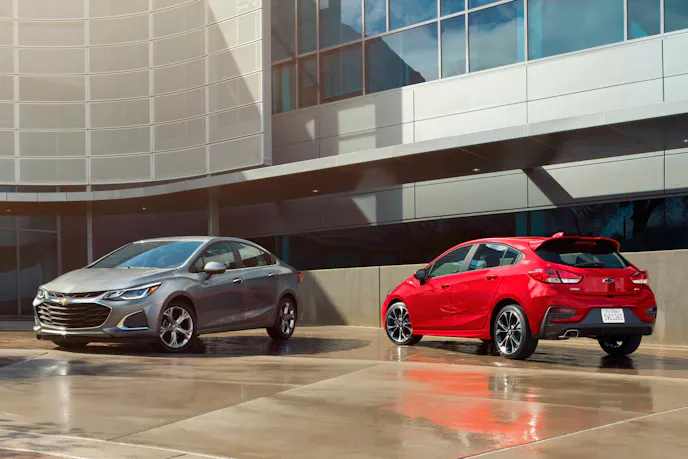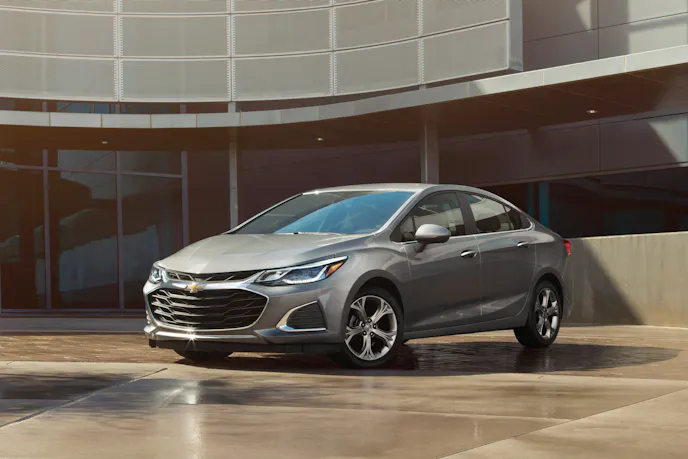Here’s the skinny on the U.S.-market diesel Chevy Cruze. Understandably forgettable, the four-door compact sedan/hatchback quietly demonstrated how good a modern oil burner could be in a commuter package.
Diesel Chevy Cruze Engines
Chevrolet brought the Cruze Diesel to America in two distinct waves. The first arrived for 2014–2015 with a 2.0-liter turbodiesel (RPO LUZ). It was rated at 151 hp and 264 lb-ft of torque, with a brief overboost to ~280 lb-ft, routed through a six-speed automatic. After a one-year gap, the second-gen Cruze returned for 2017–2019 with the all-aluminum 1.6-liter “Whisper Diesel” (RPO LH7). Output was 137 hp and 240 lb-ft, paired to either a six-speed manual (2017 and 2018) or a slick nine-speed automatic. The sedan could be had with either gearbox; the hatch joined later.
Visual Differences
Spotting a diesel Cruze wasn’t easy. The 2014–2015 models featured a small “Diesel” badge on the trunk lid—about the only clear identifier—and often came equipped with LT or LTZ trim-level features, such as fog lamps and 17-inch alloys. Inside, the diesel’s lower redline tachometer was one of the few clues you weren’t in a gas model. Later 2017–2019 cars dropped the exterior badge entirely, leaving only a discreet DEF filler cap under the fuel door and a faint diesel rattle at idle to give it away. Chevy kept the diesel Cruze’s look clean and understated—perfect for enthusiasts who preferred stealth over show.

What Made The Diesel Cruze Good
For enthusiasts who rack up highway miles, the diesel Cruze’s real draw was effortless torque and range. The 2.0-liter pulled like a bigger car from 1,500–3,000 rpm, making merges and two-lane passes easy without a downshift frenzy. The later 1.6-liter was more about refinement than peak numbers. It idled clean, stayed quiet at cruise, and delivered seriously long legs—think 700+ miles on a 13.5-gallon fuel tank when driven sanely.
Both engines utilized modern aftertreatment systems (DPF + SCR/DEF), resulting in low soot and NOx emissions, as well as the ability to operate with taller gearing for relaxed, low-rpm cruising. The nine-speed auto in the LH7 kept revs barely above idle at freeway speeds, and the manual option gave diesel die-hards a rare, engaging commuter in the States. The real-world economy was stellar: EPA highway figures peaked in the high 40s to low 50s mpg for certain 1.6-liter trims, and many owners reported achieving 45–50 mpg without babying it.
Chassis-wise, the Cruze wasn’t a hot hatch, but it was planted and mature. The diesel’s torque was well-suited to the gearing, and the additional sound deadening made it feel more grown-up than most compacts. For those who drove a lot on the freeway, it simply did the job better than nearly anything in its price class.

Why The Diesel Chevy Cruze Disappeared
Two headwinds killed it. First, the market shift: by 2018–2019, U.S. buyers had moved hard into crossovers, and compact sedans were getting culled across the board (the Cruze line itself ended after 2019 in North America). Second, diesel demand plummeted after 2015 as emissions scrutiny intensified and gasoline prices were low. Meeting ever-tighter U.S. emissions standards meant costly aftertreatment hardware, extra engineering, and certification complexity—hard to justify with tiny take rates. Even though the Cruze Diesel delivered on its promise, the business case didn’t.
A Satisfying Commuter
If you find a clean example (a quick search shows they run around $5,000 on Marketplace) the diesel Cruze is a uniquely satisfying commuter: torque-rich, serene at 75 mph, and capable of road-trip range that embarrasses hybrids. It didn’t completely fail on merit—it was a victim of the market.
You might also like
This Killer Creations Apache Houses A Triple-Turbo Cummins
Few trucks have crashed onto the diesel performance scene with the force of the Killer Creations Apache—a wild triple-turbo bruiser.


